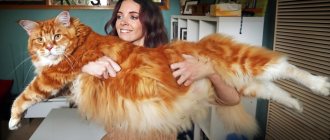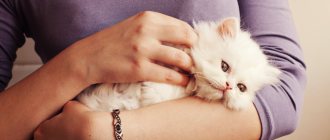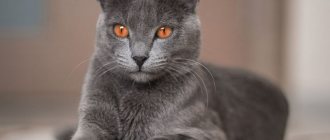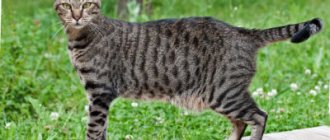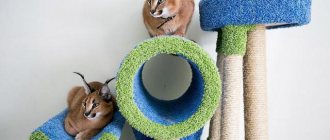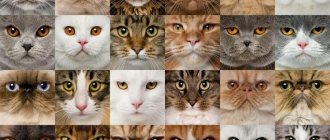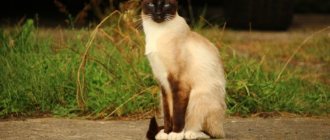Tenth place – cat of the Napoleon breed
An amazing dwarf cat with an equally amazing breed name, was bred by crossing Munchkins and Persian cats. As a result of mating, the result was a very cute and fluffy cat with an average weight of 2.3 - 4 kg. Animals of this breed are very affectionate and gentle; from the first days of being in a new home, they become incredibly attached to their new family. When caring for Napoleon, pay special attention to your pet's eyes.
Singapore cat: 2-3 kg
Singapore cat
The Singapore cat breed has a rather sad past: they began to be bred from stray animals found on the streets of the city-state of Singapore. But thanks to their unique characteristics, current representatives of Singaporean cats can claim the best place in the house, because along with their small size they are distinguished by intelligence, devotion, and love for their owner. True, Singapore has not yet become widespread.
Ninth place - bambino
Animals of this breed are short-legged hairless cats. They were the result of mating a short-legged munchkin and a Canadian Sphynx. This breed was bred in the USA, and the animals weigh 2.2 - 4 kg. Keeping a bambino is quite simple; you just need to remember that hairless cats often get sick. Therefore, in winter, if the apartment is too cold, dress your pet. This is not only good for his health, but also very stylish.
Devon Rex
Devon Rex cats are nicknamed "poodle cats" due to their wavy coat, high intelligence, and outgoing nature. This unique breed originated in the 1950s in Devon, England. They are distinguished by mischievous faces, high ears, huge eyes and a slender physique. The Devon Rex loves to play and climb, so it is perfect for active owners who can devote a lot of time and attention to their pet. These super social cats love people and love making new friends. They crave attention and do not tolerate loneliness well.
The Devon Rex has an elfin, almost alien appearance. This is a medium-sized cat, weighing 2.7-4.1 kg and standing about 25.4-30.5 cm in height. These curly cuties have fine, thick and wavy fur. Their fur is short, but it is especially short and less dense around the head, ears, neck, paws, chest and belly. This breed is not hypoallergenic.
Cuddling and fooling around with their owners is the Devon Rex's favorite pastime. He is not aggressive and prefers to walk away rather than deal with rude people. These cats remain playful into old age, maintaining the energy of a kitten well into old age. Although the Devon Rex can be a little demanding, it is not a particularly noisy cat breed.
They are highly intelligent, easy to train, play maze games and can learn complex tricks. However, these stubborn cats are difficult to motivate. Praise, games, and snacks are good tools.
Caring for a Devon Rex is quite simple. But it is worth considering that his short coat can easily become oily, so your pet needs to be regularly bathed in warm water with a mild pet shampoo.
Seventh place - munchkin
This cat breed was the result of a natural mutation. The main feature of cats is their short legs. Due to their appearance, animals of this breed are original and cute. The short legs of the munchkins did their job, and this breed is incredibly popular and in demand. In 2014, the American Munchkin received the status of the shortest cat in the world and was included in the Guinness Book of Records. The cat's height was only 13.34 cm. Adults of this breed weigh up to 4 kg.
American Curl
The American Curl comes in a wide range of sizes due to its diverse gene pool, however most tend to be quite petite. Their most famous feature is the curled ears towards the base of the skull, which give the breed its name. The unusual bend gives the ears the appearance of ears turned inside out. For show cats, ears are the most stringent criterion. Representatives of the breed whose ears are curled too far (more than 180 degrees) or insufficiently (less than 90 degrees) will be disqualified.
The American Curl was first bred in 1981 in Lakewood, California. A black long-haired cat named Shulamith became the progenitor of a new breed, from which every American Curl today can trace their ancestry. The curvature of her ears was a spontaneous, natural mutation that manifested itself as a dominant gene. More in-depth laboratory testing showed that the mutation did not lead to additional defects or health problems. Shulamith's offspring were absolutely healthy and stable cats.
At birth, their ears are erect; they begin to curl after 2-10 days. The ears curl and unfold to varying degrees over the next four months. When the ears take their final shape, the lower two-thirds of the ear is hard cartilage rather than soft flesh like most cat breeds. The upper third remains soft and pliable. You need to be careful with the ears of the American Curl so as not to damage the hard cartilage. But in other respects they are a fairly unpretentious breed.
The American Curl has a wedge-shaped muzzle, an elongated body and round eyes. The height of cats varies from 22 to 30 cm. The curly coat is long or short. They are friendly, captivating and incredibly cute pets. The American Curl, which remains energetic into adulthood, has been nicknamed “the cat’s Peter Pan.” Cats reach maturity at 2-3 years, so they retain the energy of a kitten into adulthood.
This is not a very vocal cat breed and in most cases they express affection through physical contact. The American Curl is an extremely adaptable cat, getting along well with other cats and quickly adapting to new family members. If necessary, they will do well alone for long periods of time.
Sixth place – Skookum cats
This breed was bred by mating a short-legged munchkin and a long-haired Laperm cat. As a result of selection, short-legged kittens with long curly hair and a weight of 1.8 to 3.6 kg were obtained. Given the unique structure of the coat, animals of this breed require special care. Skookum are kind and affectionate cats that delight their owners every day.
Japanese Bobtail
This breed makes excellent pets. Japanese Bobtails are valued for their short curved tails, playful nature and hyperactivity. This adorable breed originates from Japan but is famous all over the world. The Japanese Bobtail is an ancient breed, bred back in the 6th century. These cats were often used to control rodents on farms. Although the Japanese Bobtail was once considered a luxurious pet, inaccessible to ordinary people. These cute, quirky cats are relatively rare outside of their homeland.
The defining physical characteristic of the Japanese Bobtail is, of course, the “clipped” cat tail. It looks more like a rabbit than a cat. The tail of the Japanese Bobtail is usually no longer than 7 cm, covered with tufts of fur and curled or curled to one side. Just like fingerprints, no two tails of this breed are alike.
The Japanese Bobtail is a short breed, growing to a maximum of 23 cm. Cats weigh 2.7-4.5 kg. They have long and muscular bodies, high cheekbones and oval eyes. Their forelimbs are slightly shorter than their hind limbs. Japanese Bobtails have two types of coat: long and short. The coloration can be solid, two-tone or striped, but the most common are white cats with colored spots. The coat is silky smooth, easy to care for and low shedding. They have no undercoat, so their hair is not prone to tangling. It is recommended to brush the coat once a week to remove dead hairs.
Japanese Bobtails are stubborn and courageous and are not easily intimidated. These energetic animals are especially loyal with children, dogs and other cats, especially other bobtails. They remain active for most of their lives. Japanese Bobtails are sociable, friendly and very intelligent. These cats love to be the center of attention, often attracting attention with their gentle melodious voices. They almost always respond when spoken to.
The lively Japanese Bobtail loves activity and does not need external motivation to exercise. They love to snack, but their active lifestyle does not always prevent obesity, so you need to monitor your bobtail's treats and food intake to prevent it from gaining excess weight. This breed is considered healthy and disease resistant. The lifespan of Japanese Bobtails is 9-15 years.
In fifth place is a breed called Dwelf.
To create this breed, breeders worked hard and crossed the Munchkin, the Canadian Sphynx and the American Curl. As a result of mating, the result was a rather cute hairless kitten with short legs. Keeping a cat of this breed is not difficult, but you need to remember that by inheritance from three different breeds, the Dwelf has a stubborn character. Therefore, a cat must be raised correctly from an early age. Adults of this breed weigh from 1.8 to 3 kg.
First place – skif-tay-don
The first kitten of this breed appeared in 1988 in Rostov-on-Don. A Thai Bobtail breeder crossed a Thai cat with four kinks on its tail and a Thai cat with a non-standard donut-shaped tail. As a result of this mating, the founder of the breed was born, who was named Kutsy. In 1994, the first Scythian-Tai-Don breed standard was approved. Adult cats weigh from 900 g to 2 kg.
Miniature cats are a real decoration for every home. But remember that they need special, careful care. Because small pets cannot fend for themselves. Under no circumstances should such a cat be allowed out for a walk unattended.
The smallest cats - who are they?
Small cats are those whose weight is less than 4 kg. These breeds were bred artificially and are quite popular. Let's look at the ten smallest cats in the world, starting with the largest.
Bambino
The ancestors of the Bambino cat are the Munchkin and the Canadian Sphynx. The result was a hairless cat with short legs. Her first litter appeared in the USA in 2006. This cat weighs no more than 4 kg, and its height is 19 cm. It can be any color.
Bambino - a hybrid of the Canadian Sphynx and Munchkin
TICA and other feline organizations do not recognize the Bambino as a separate breed, but you can sometimes find information that these cats are considered a hairless variety of the Minskin.
Bambinos are bred in Moscow and St. Petersburg—here you can buy this cat from breeders for 50–70 thousand rubles.
Skookum
The ancestors of Skookums are Laperms and Munchkins. This cat appeared in 1996 in the USA. Its height is about 19 cm at the withers, and its maximum weight is 3.9 kg. The animal is active and playful - it runs quickly despite its short legs. Its color can be different - more often it includes several colors. This cat's fur is curly, especially on the chest. You can buy a Skookum from an American or European cattery, but it is difficult to find this cat from Russian breeders. Its price is unknown, but this animal is not cheap. Currently, skookum is not recognized as a separate breed by felinological organizations.
Skookum appeared after crossing La-mer and Muncchin
Minuet, or Napoleon
The Napoleon, or Minuet, breed appeared in 1995 by crossing a Persian cat and a Munchkin. The American breeder worked for a long time on its creation, but in the end he was dissatisfied with the result, castrating all the remaining individuals. But other breeders liked the beautiful creatures he bred, so the business was soon continued. The maximum weight of these cats is 3.5 kg. In 2021, this breed is recognized by TICA as a full breed in its own right.
The Napoleon cat is a cross between a munchkin and a Persian cat.
Napoleon got his appearance from his Persian ancestors, and his dimensions from munchkins. The color of the animal can be different, usually it combines several colors at once. Napoleon costs from 30 thousand rubles. It can be purchased from Russian or American breeders.
My friend in Cyprus has a cat of the Napoleon breed. When she first bought her and brought her into the house, the cat looked at all the members of her new family and for some reason went to her grandmother, whom she had never seen before. The animal jumped onto grandma’s lap, and when she petted her, she jumped off her lap and settled down near grandma’s feet. The cat sat there until the grandmother decided to go to her room. The cat accordingly followed her. Since then, she has lived like this with her grandmother, only occasionally going out to assess the situation and look at all the residents of the house with her languid, dissatisfied gaze.
Dwelf
Dwelf is a hybrid of three breeds:
- American Curl;
- Canadian Sphynx;
- munchkin.
Dwelfs are rarely found among Russian breeders. They weigh up to 3.3 kg and have no fur. They have a long tail, and their legs are strong and short.
When planning to purchase such a pet, you need to take into account that caring for him is not so easy due to frequent health problems. The cat is distinguished by its large, backward-curved ears. The color of the animal can be different, like its ancestors - from white to dark brown.
Dwelf - hybrid of the Munchkin, the Canadian Sphynx and the American Curl
This breed was recognized by the TDCA in 2009. There are only a few dozen of its representatives in the world. You can purchase a kitten of this breed from breeders. Its price is from 120 thousand rubles.
Kinkaloe
Kinkalow cats have appeared recently, so there are still very few of their representatives in the world. As an adult, the cat weighs no more than 3 kg. Despite its miniature appearance, the animal has a fairly strong physique. It has a rather thick coat that needs careful grooming. The color of the animal can be different, both monochromatic and multi-colored. This cat's tail is small - no more than 10 cm, and its paws are strong, but miniature. The animal has an unusual (curved) shape of ears. Kinkalow cats inherited this feature from American Curls, which were crossed with Munchkins. The animal can be purchased at a nursery or at an exhibition. The price of a kitten is from 45 thousand rubles.
Kinkalow cats have an unusual (curved) ear shape.
The Kinkalow breed is not yet officially recognized by felinological organizations.
Minskin
Minskin weighs no more than 2.9 kg, and its length is about 19 cm. It appeared in the USA in 2000. Four breeds of cats took part in its creation:
- munchkin;
- Canadian Sphynx;
- Devon Rex;
- Burmese
Minskin is a small short-haired cat.
The fur of these cats can have different colors. To the touch, the skin of such an animal resembles cashmere. By nature, this is a confident and curious cat that does not tolerate loneliness well. There are about 100 individuals of the Minskin all over the world, so the price for it is still unstable and high. It is quite difficult to find such an animal from breeders. In 2005, Minskin was provisionally recognized by TICA.
Munchkin
The Munchkin is a short cat with a short and elongated body, which is why breeders often call it a “cat dachshund.” The cat's weight is about 2.9 kg, height is 13–17 cm. The animal has a large, strong tail, which it rests on when sitting. Due to its unusual structure, this cat often has problems with the spine. The Munchkin breed appeared as a result of a mutation in the USA in 1983. The color of the cat is varied, from white to dark brown, but usually the animal is not one color. The cat can be purchased from breeders or at an exhibition. Its price is from 25 thousand rubles. Munchkin was recognized by TICA in 2003.
The Munchkin breed appeared as a result of mutation
Next door to my friend lives a breeder of cats, including a munchkin. My friend cannot afford to have a pet because she is constantly at work - she believes that the animal will be homesick, which is true. Meanwhile, my friend loves animals very much and strives for them “with all her soul.” Therefore, she often visits her neighbor and simply “bathes” in the love of his many cats. So, according to her, munchkins behave like ordinary cats - they are unpretentious and love affection. However, their appearance, as a friend says, is painfully pitiful, since they look like inferior animals with long lower legs and short front legs. Well, everyone has their own opinion.
Skif-tay-don
The weight of the skif-tay-don can reach up to 2.8 kg. As an adult, this animal looks like a 4-month-old kitten of a yard cat. Despite this, the skif-day-ton is well physically developed, which is explained by its strong muscles. The animal's tail has a rounded shape, the size of the tail is no more than 7 cm. The color of the animal's body is light, almost white, and the tips of the paws and tail, ears, and part of the muzzle are dark (silpoint).
Skif-Tai-Don's hind legs are longer than its front legs
In 1983, a family living in Rostov-on-Don received a Siamese cat with a tail defect. Family members were breeders of Thai Bobtails. They also had a Siamese cat with a short tail. Soon she and the Siamese cat had kittens, of which one “baby” also had a short tail. This was the first representative of the breed. There are many breeders of these cats in Russia, and you can buy an animal from them. The cost of a kitten is from 70 thousand rubles. These cats were recognized by many organizations in 2021 - ASC, FARUS, AFC, WACC, AFK, etc.
Singapore
The Singapura, or Singapura cat, is listed in the Guinness Book of Records as the smallest cat in the world. It weighs no more than 2.7 kg and is golden-cream in color. The cat's body is muscular, and in size it resembles a 4-month-old kitten of a yard cat.
The Singaporean's character is flexible and calm.
The cat has a calm character - it will be comfortable to spend autumn and winter evenings next to her.
The history of the appearance of the breed is very interesting. In the mid-70s, small animals appeared in Singapore, which were not paid attention to by local residents. These cats lived in the basements of houses and ate scraps from garbage cans. But American and European officials who visited the city noticed interesting animals. They took them by ship to the northern part of the United States. Since then, cats have adapted and changed a little in appearance. In Russia, it is quite difficult to buy a real purebred Singaporean. In the few nurseries that exist in the country, the cost of a cat is high - from 50 thousand and above. In 1979, the breed was recognized by the TICA organization, and later by the CFA system.
Tinker-toy
This animal, 19 cm long, 7 cm high and weighing 681 g, was listed in the Guinness Book of Records. A Himalayan-Persian cat named Tinker-Toy became famous in 1994, and three years later he was gone. There is no information about what color, disposition and appearance the cat had.

